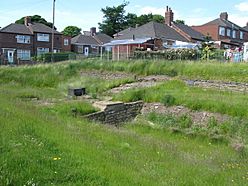Condercum facts for kids
Quick facts for kids Condercum |
|
|---|---|

The Vallum crossing at Condercum
|
|
| Founded | 122 - 124 AD |
| Abandoned | c. 5th century AD |
| Place in the Roman world | |
| Province | Britannia |
| Structure | |
| — Stone structure — | |
| Size and area | 170 m × 120 m (2 ha) |
| Stationed military units | |
| — Legions — | |
|
|
| — Cohorts — | |
| I Vangionum | |
| — Alae — | |
| Hispanorum Asturum | |
| Location | |
| Coordinates | 54°58′34″N 1°39′47″W / 54.976°N 1.663°W |
| Town | Newcastle upon Tyne |
| County | Tyne and Wear |
| Country | England |
| Reference | |
| UK-OSNG reference | NZ216646 |
Condercum was an old Roman fort. It was located where the Condercum Estate is today, in Benwell, near Newcastle upon Tyne, England. It was the third fort built along Hadrian's Wall, a famous Roman barrier. It stood on a hilltop about 2 miles (3.2 km) west of Newcastle.
Sadly, you can't see the fort today. A modern reservoir and houses cover the spot. The A186 road, which follows Hadrian's Wall, also cuts through the area. But you can still see parts of a small temple nearby. It was built for Antenociticus, a local god. You can also see the original path that crossed the vallum, which was a large ditch behind the wall. A street called Condercum Road now marks the area.
Contents
What Condercum Looked Like
The remains of the fort are found west of Newcastle, along Hadrian's Wall. The fort was about 570 feet (170 m) long from north to south. It was also about 400 feet (120 m) wide from east to west. The fort's defenses covered an area of just over 5 acres (2 hectares).
Condercum was a cavalry fort, meaning it housed Roman soldiers who rode horses. It had three gates that led to the north side of Hadrian's Wall. There were also two side gates, facing east and west. The main Roman military road, which ran along the south side of the wall, used these gates.
A south-facing gate led to a special path that crossed the vallum. This path had a gate in the middle that could be closed. Inside the fort, there were many important buildings. These included the commander's house, the main headquarters, and two large granaries for storing grain. There were also workshops, barracks for soldiers, stables for horses, and a hospital.
Discoveries at the Fort
Archaeologists dug up parts of the fort in the 1920s and 1930s. They found a special stone tablet that helped them figure out the fort was built around 122 AD. They also found pottery from the 2nd century, which showed when the fort was rebuilt.
Other interesting things found at the site include altars dedicated to different gods. They also found brooches, which are decorative pins, and a strong room or treasure vault. A silver spoon was also among the discoveries.
Building the Fort and Its Soldiers
We know from special building inscriptions that soldiers from the Second Augustan Legion (Legio II Augusta) built the fort's defenses. It's believed they built it between 122 AD and 124 AD. Soldiers from the Twentieth Legion (Legio XX Valeria Victrix) also did some building or repair work later, in the late 2nd century.
The fort had two large granaries. These were built by a group from the British Fleet. This probably happened because the main legionary soldiers were called away. It's likely this group came from Arbeia, a nearby Roman fort in what is now South Shields.
In the 2nd century, the fort at Condercum was home to the Cohors I Vangionum Milliaria Equitata. This was a unit from Upper Germany that had both foot soldiers and cavalry. It was supposed to have a thousand men, but probably only half that number lived at the fort. Later, from about 205 AD to 367 AD, a cavalry unit of 500 men was stationed there. These soldiers, called the Ala I Hispanorum Asturum, came from the Astures tribe in northern Spain.
Other Buildings Around the Fort
There is proof that a small village, called a vicus, grew up around the fort. This village was located both north and south of the vallum. Archaeologists found the remains of three important buildings near the fort.
Many altar-stones have been found at the site. These stones were dedicated to different gods. Three of these altars were for Antenociticus, who is thought to be a Celtic god. Another dedication to the "three lamiae" might also refer to local Celtic gods.
About a hundred yards (90 m) east of the fort, you can still see the remains of a temple dedicated to Antenociticus. This building was found in 1862. It measures about 15 feet (4.6 m) from east to west and 20 feet (6.1 m) from north to south. It also has a rounded end, called an apse, that sticks out another six feet (1.8 m). People believe the apse held a life-size statue of the god. This is because a full-size head, along with parts of an arm and a leg, were found there. The head wore a Celtic neck torc. The temple also had three altars for Antenociticus.
About three hundred yards (270 m) southwest of the fort, a bathhouse was discovered in 1751. This building had several rooms. These were likely the hot and cold rooms and dressing rooms that were common in Roman bathhouses.
Just south of the vallum pathway, a third building was found. This was a large house. It is believed to have been a mansio, which was a guesthouse for official travelers.
Images for kids






